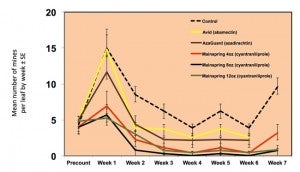Leafminer Control — 2014 IR-4 Trial Results
Results of recent IR-4 trial of pesticides for leafminer control conducted in the Parrella lab are now available. The purpose of this trial was to evaluate the efficacy of new and currently-registered materials against the American serpentine leafminer, Liriomyza trifolii, in greenhouse-grown cut gerbera daisy (Gerbera x hybrida ‘Mermaid’). Avid and AzaGuard were the two materials tested that are currently labeled for leafminer control in greenhouse ornamental crops.
While all treatments reduced leafminer levels, a few of the materials provided outstanding control. To facilitate review of the results, we have produced one graph showing the five best materials. Click here to see the statistical analysis for this data.

Leafminer control achieved with the best five products. All reduced leafminer levels to less than five mines per leaf.
Avid (abamectin), AzaGuard (azadirachtin), and the three Mainspring (cyantraniliprole) treatments provided excellent leafminer control, with all products reducing leafminers to fewer than five mines per leaf by the second week of the trial. There are no published thresholds for leafminer on gerbera daisy, but this is a commonly accepted action threshold.
Among these products, however, there were differences in the duration of control and number of applications needed. Control with Avid lasted for four weeks after the second application, while AzaGuard provided only a week of control after three applications. Mainspring provided excellent control at all tested rates. A single drench application at the highest rate reduced leafminers to three mines per leaf after two weeks and held them below one mine per leaf for an additional five weeks. While not as effective, the other two Mainspring treatments also gave excellent control with three applications maintaining leafminer levels below five per leaf for the duration of the trial. As each has a different mode of action, Avid, AzaGuard, and Mainspring could form an effective leafminer rotation.
The other tested materials were also effective at reducing the high leafminer populations seen in the first week of the trial but none was able to consistently maintain leafminers at levels below an average of five mines per leaf. Click here for complete trial results.
Thanks to the IR-4 program for financial support. The trial was conducted by Robert Starnes, Machiko Murdock, and Danny Klittich. Statistical analysis and graphs by the author.
- Posted by
 cacasey
cacasey - Posted in IR-4, Leafminers, Pesticide trials
 Feb, 11, 2015
Feb, 11, 2015 Comments Off on Leafminer Control — 2014 IR-4 Trial Results
Comments Off on Leafminer Control — 2014 IR-4 Trial Results
 (530) 752-4784
(530) 752-4784 Join Us On Facebook
Join Us On Facebook Join Us On Twitter
Join Us On Twitter Join Us On In.com
Join Us On In.com Subscribe to RSS
Subscribe to RSS Follow Us On Google+
Follow Us On Google+ Subscribe Us On Youtube
Subscribe Us On Youtube Follow Us On Pinterest
Follow Us On Pinterest Follow Us On Instagram
Follow Us On Instagram Follow Us On Tumblr
Follow Us On Tumblr Subscribe Us On Flickr
Subscribe Us On Flickr